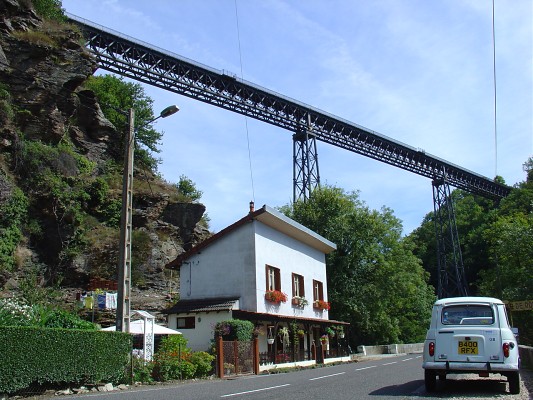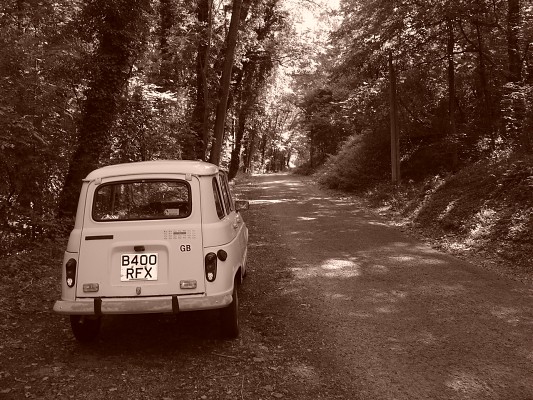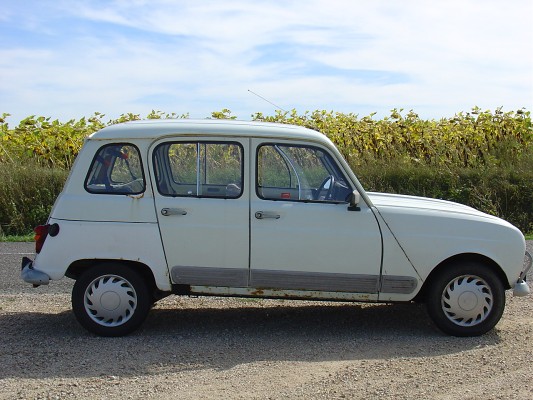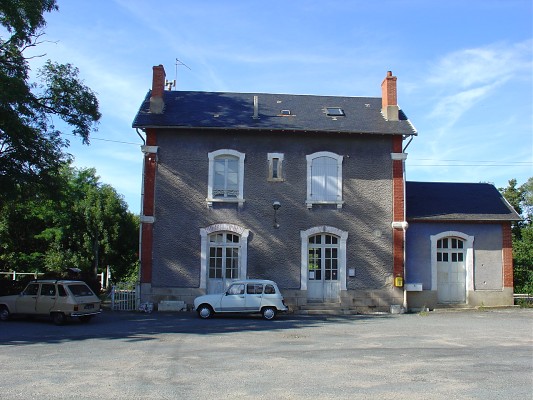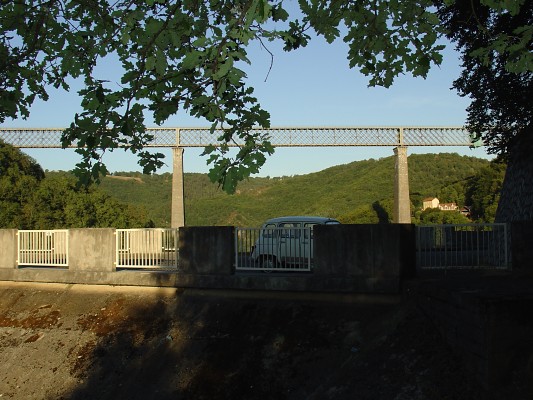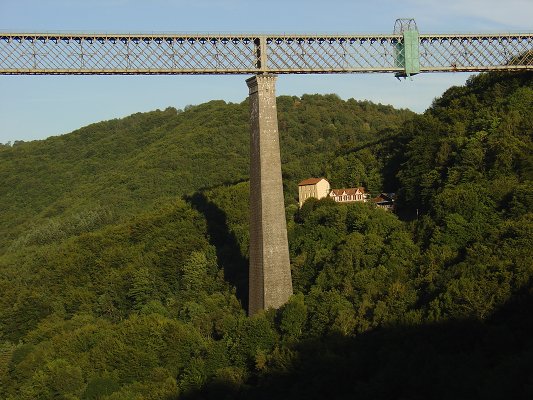
Reflexia Meets Eiffel
page 2 of 4
by Peter Gumbrell, 18 September 2005, updated 19 October 2009 and 9 April 2010
continued from part 1
My first free weekend during the trip, and I take the Renault 4 for a drive around the region west of Vichy, in the south-west of l'Allier. The scenery didn't promise to be as dramatic as that found further south in the mountains of the Auvergne, but I was surprised nonetheless at how pretty and diverse much of this area was. From the high plains north of Gannat to the forests further west, and a few picturesque valleys and winding lanes thrown in, this was a quiet part of the countryside away from any tourist activity. A leaflet on the Allier region had made brief reference to a few Eiffel viaducts, and so my plan was to track them down and take in a couple of towns on the way.
Being a Sunday in rural France, little was happening, and the sleepy town of Gannat had no signs of activity but for a few pratts in hot-hatches gathering in the pretty main square and ruining it with booming bass boxes. I have to say that after experiencing all the best sides of France and its people during previous visits, this extended stay confronted me with many less attractive sides to French life that I hadn't expected. I was dismayed to find that the illusion I had always cast in my mind of this country being free of the same types of idiots that roam the British landscape was to be very much demolished. There were just as many low-life characters to be found here also, zooming around Vichy day and night on their motorbikes and in their souped up cars with big-bore exhausts. Unfortunately, it would appear to be a phenomenon increasingly common the world over. The only notable difference here in France was that there were a lot more old bangers like mine still on the roads, and less of a desire for people to rid of reliable old cars and replace them with glossy crap that they could parade in front of Mr and Mrs Jones next door. Hence, many of the lads riding cars around the streets chose tatty old hatchbacks and other rusted, aged sports models instead of the latest show-off new offerings.
The first photo (above) shows my first encounter with one of Eiffel's grand viaducts, at Rouzat, north of Gannat. It was a truly impressive structure spanning a river and wide gorge. Another of Eiffel's viaducts, similar in style though slightly less spectacular in location, was situated a few kilometres up the road at Neuvial, from where the picture below was taken (the viaduct itself isn't visible).
Heading further west, I stopped aside a field of sunflowers to capture Reflexia in the glorious sunny surroundings (below). Alas, you can see here the extent of rot developing on the driver's side. The blobby patch around the rear quarter window is clearly visible, as is the rust on the outer sill, and you may also be able to see the black area at the rear of this sill, where welding had to be performed for the car's recent MOT. This involved cutting a section of the outer sill in order to access the rear suspension area inside, then welding the part back on. It was done professionally by an able mechanic, but left unpainted or retouched with the black coating. On closer inspection, the car has a lot of rust all over, despite the chassis being in a good state for its age. With there being far too much for me alone to attempt to patch up, I couldn't be sure at this stage to what lengths I might go in attending to it. Perhaps the worst parts would be mended before the winter, but it would be impossible to achieve perfection with this car without spending inordinate amounts of money.
An excursion further north-west took me to the villages of Louroux-de-Bouble and Coutansouze, in between which lay another impressive viaduct spanning a wide valley. At the station located in the former of these two villages, I discovered a Renault 6 parked outside (below).
Another photo from this location appears in the mystery cars section of the gallery (number MC101). At Coutansouze, I spotted another Renault 4 on a country lane. I had already seen so many quatrelles since the moment I made it onto French shores, that I decided there was no point filling my camera's memory with photos of them all, let alone wasting my holiday time snapping them all and filling pages of this website with a couple of hundred images. Just one made it onto the site because of the peculiar animals strutting around in the road ahead of it, and hence it can also be found, slightly spuriously, on the pets page in the playroom (number PE16).
Saving the best till last, I spotted another viaduct on my map, further south near St-Gervais-d'Auvergne. Unsure if it would prove to be as impressive as the other three, since it wasn't mentioned in the guide I had read earlier, I realised that it lay outside the Allier region which this guide promoted, and that none of those others were noted on my atlas. I decided that for this reason it had to be good, and I breezed through tiny winding country lanes to reach it before sunset. Upon descending a hill winding around a valley, I caught first sight of the bridge and knew that my journey hadn't been in vain. Although only partly visible through the trees, I could see that this was one mighty achievement of engineering. Not one of the many photos or videos I took at the site could really do it justice, and the picture below is the only one featuring the Renault 4.
Sadly, the structure had been neglected, and the few buildings dotted close to it on the hillside appeared to be abandoned. For such a magnificent creation it was a real shame, not least to notice that on this Sunday summer's evening only one or two passing cars were bothering to stop to admire it and the stunning surroundings. Behind the viaduct, on the other side of the dam on which my Renault 4 is pictured above, lies a huge reservoir shrouded by forested hills, a truly dramatic and beautiful location. Although it's well out of the way of most tourist routes, I would recommend anybody touring nearby, especially in their Renault 4, to pay a visit.
The bridge is called the Viaduc des Fades, and lies some 30km north-west of the city of Clermont-Ferrand. I drove further up the adjoining hillside, and found a turn-off with directions pointing to the station. Intrigued, I followed the road to the top of the hill, passing a few feet under the viaduct at its southern end. There was an old station building looking rather dilapidated, but on walking past I spotted a face peering at me from behind the curtains. The station itself was also run down and overgrown, and fenced off from trespassers. There were relics of another age still visible, from when this was probably a major tourist attraction for French holidaymakers in the early twentieth century. I felt saddened that it had lapsed into this state, although one piece of the huge girder structure was being repainted. This was reminiscent of the Forth Bridge in Scotland, where one section is always under repair, because by the time every part has been attended to it has become necessary to start from the beginning again. Although not as elaborate in design or on quite the same scale, I was overwhelmed at this construction and put it on a par with some of the best sights I'd seen elsewhere, including even the Golden Gate Bridge in San Francisco.
This image demonstrates a little better the colossal scale of the viaduct. Trains run along the upper level, rather than inside the box section, and visible in this picture is a piece of green scaffold arching over the top section, which must allow a train to pass underneath it. Look again at the earlier photo to envisage the train and its relation to the size of the viaduct and the surrounding valley.
Clearly, this bridge was just never famous enough, in part due to being located in a rural area, and on a line now disused and unlikely to be in demand for use in the future. I strolled down a path on the hillside to get another angle on the viaduct, when I heard a rumble that gained in volume. The roads were very quiet, and I couldn't imagine what a lorry was doing coming up this small lane at such a time of the evening. Suddenly, I was astonished to see a diesel engine crossing the bridge at slow speed. Although the line was overgrown and bumpy, in a state of disrepair, traffic was still passing over it, if only for servicing or maintenance. I was so happy to know that it was still in use. An engineering marvel like this shouldn't be left to ruin. The span of the valley was immense, the box sections enormous, and I couldn't believe that any engineer of yesteryear could for one moment have conceived that crossing this gorge on a train could be remotely possible. That engineer, one Félix Virard, certainly designed on an Eiffel-like scale, realising the completion of the project in 1909. Almost one century on, I left contented that my Renault 4 had taken me to one of the wonders of France, and that both the car and the bridge were still alive.
Update October 2009: Further research on the Viaduc des Fades has thrown up some alarming news. The last train movements across the bridge were in 2007. The structure has since been closed and is falling into disrepair. A similar fate also now hangs over the viaduct featured on the next page, which saw its final train pass only last month in September 2009, due to cracks found in the beams. Further reading on the Viaduc des Fades, and an urgent campaign to try and save it, can be found at this site (in French).
<< previous article | next article >>
